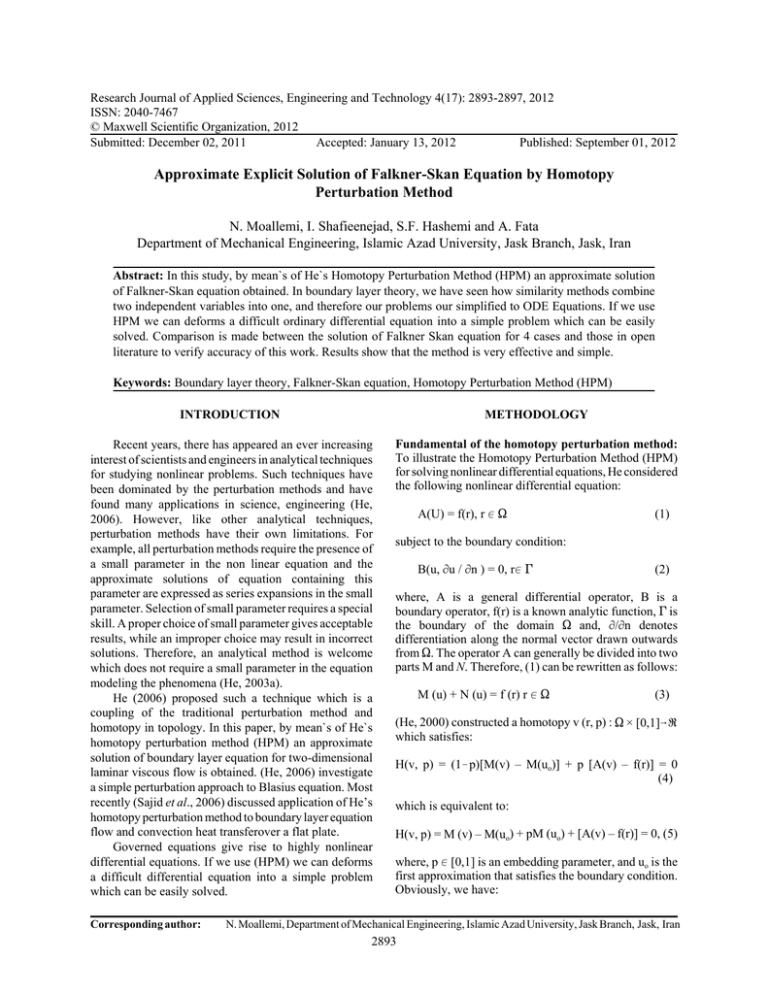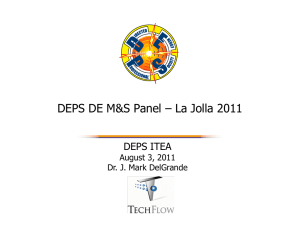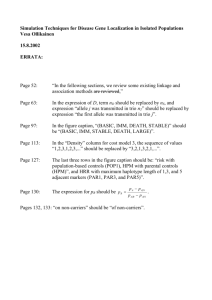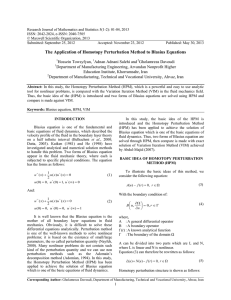Research Journal of Applied Sciences, Engineering and Technology 4(17): 2893-2897,... ISSN: 2040-7467
advertisement

Research Journal of Applied Sciences, Engineering and Technology 4(17): 2893-2897, 2012 ISSN: 2040-7467 © Maxwell Scientific Organization, 2012 Submitted: December 02, 2011 Accepted: January 13, 2012 Published: September 01, 2012 Approximate Explicit Solution of Falkner-Skan Equation by Homotopy Perturbation Method N. Moallemi, I. Shafieenejad, S.F. Hashemi and A. Fata Department of Mechanical Engineering, Islamic Azad University, Jask Branch, Jask, Iran Abstract: In this study, by mean`s of He`s Homotopy Perturbation Method (HPM) an approximate solution of Falkner-Skan equation obtained. In boundary layer theory, we have seen how similarity methods combine two independent variables into one, and therefore our problems our simplified to ODE Equations. If we use HPM we can deforms a difficult ordinary differential equation into a simple problem which can be easily solved. Comparison is made between the solution of Falkner Skan equation for 4 cases and those in open literature to verify accuracy of this work. Results show that the method is very effective and simple. Keywords: Boundary layer theory, Falkner-Skan equation, Homotopy Perturbation Method (HPM) INTRODUCTION METHODOLOGY Recent years, there has appeared an ever increasing interest of scientists and engineers in analytical techniques for studying nonlinear problems. Such techniques have been dominated by the perturbation methods and have found many applications in science, engineering (He, 2006). However, like other analytical techniques, perturbation methods have their own limitations. For example, all perturbation methods require the presence of a small parameter in the non linear equation and the approximate solutions of equation containing this parameter are expressed as series expansions in the small parameter. Selection of small parameter requires a special skill. A proper choice of small parameter gives acceptable results, while an improper choice may result in incorrect solutions. Therefore, an analytical method is welcome which does not require a small parameter in the equation modeling the phenomena (He, 2003a). He (2006) proposed such a technique which is a coupling of the traditional perturbation method and homotopy in topology. In this paper, by mean`s of He`s homotopy perturbation method (HPM) an approximate solution of boundary layer equation for two-dimensional laminar viscous flow is obtained. (He, 2006) investigate a simple perturbation approach to Blasius equation. Most recently (Sajid et al., 2006) discussed application of He’s homotopy perturbation method to boundary layer equation flow and convection heat transferover a flat plate. Governed equations give rise to highly nonlinear differential equations. If we use (HPM) we can deforms a difficult differential equation into a simple problem which can be easily solved. Fundamental of the homotopy perturbation method: To illustrate the Homotopy Perturbation Method (HPM) for solving nonlinear differential equations, He considered the following nonlinear differential equation: Corresponding author: A(U) = f(r), r 0 S (1) subject to the boundary condition: B(u, Mu / Mn ) = 0, r0 ' (2) where, A is a general differential operator, B is a boundary operator, f(r) is a known analytic function, ' is the boundary of the domain S and, M/Mn denotes differentiation along the normal vector drawn outwards from S. The operator A can generally be divided into two parts M and N. Therefore, (1) can be rewritten as follows: M (u) + N (u) = f (r) r 0 S (3) (He, 2000) constructed a homotopy v (r, p) : S × [0,1]6U which satisfies: H(v, p) = (1!p)[M(v) – M(uo)] + p [A(v) – f(r)] = 0 (4) which is equivalent to: H(v, p) = M (v) – M(uo) + pM (uo) + [A(v) – f(r)] = 0, (5) where, p 0 [0,1] is an embedding parameter, and uo is the first approximation that satisfies the boundary condition. Obviously, we have: N. Moallemi, Department of Mechanical Engineering, Islamic Azad University, Jask Branch, Jask, Iran 2893 Res. J. App. Sci. Eng. Technol., 4(17): 2893-2897, 2012 H(v,0) = M (v) – M(uo) = 0 (6) H(v,1) = A (v) – f(r) = 0 (7) M = d3/d03(C) (14) and The changing process of p from zero to unity is just that of H(v, p) from M (v) – M(uo) to A (v) – f(r). In topology, this is called deformation and M (v) – M(uo) and A (v) – f(r) are called homotopic. According to the homotopy perturbation method, the parameter p is used as a small parameter, and the solution of Eq. (4) can be expressed as a series in p in the form: v = v0 + pv1 + p2v2 + p3v3 + … 2 ⎡ ⎛ d ⎛ d2 ⎞ ⎞ ⎤ ( • )⎟ ⎥ (15) N = α ⎜ 2 ( • )⎟ ( • ) + β ⎢1 − ⎜ ⎝ dη ⎠ ⎣⎢ ⎝ dη ⎠ ⎥⎦ then, construct homotopy v (r, p) :S×[0, 1] 6U witch satisfies: (8) H (f, p) = (1-p) M(f) – M (go)) + p[M(f) + N (f)] = 0 (16) when p-1, Eq. (4) corresponds to the original one, Eq. (3) and (8) becomes the approximate solution of Eq. (3), i.e., u = lim v = v 0 + v1 + v2 + v3 +... ⎤ ⎡d3 f ⎛ d2 f ⎞ ⎥ ⎢ 3 + α⎜ 2 ⎟ 3 3 η η d d ⎠ ⎝ ⎛ d f d go ⎞ ⎥ ⎢ ⎟ + p⎢ (1 − p) ⎜ − 2 ⎥ = 0 ⎡ ⎛ d ⎤ ⎝ dη 3 dη 3 ⎠ ⎞ ⎢ ( f ) + β ⎢1 − ⎜ ( f )⎟ ⎥ ⎥ ⎢ ⎝ ⎠ ⎥⎦ ⎥ η d ⎢ ⎣ ⎦ ⎣ (9) p →1 the convergence of the series in Eq. (9) is discussed by He (2000). Problem formulation: We will consider two-dimensional laminar viscous flow governed by Eq. (10) which is named as Falkner Skan equation: ( ) where, p0[0,1] is the embedding parameter and uo is the initial guess, accordingly to HPM and with respect to boundary conditions Eq. (11), we assume that Eq. (17) has the solution of the form: f (η) + α f (η) f (η) + β 1 − ( f (η)) = 0 2 for η ∈ [0, + ∞ ] f (0, p) = fo (0) + p f1 (0) + p2f2 (0) +… (11) where the prime denotes the derivative with respect to h which is defined as: η= y U vx by substituting Eq. (18) into (17) and (16), then equating the same powers of p and choosing powers of p from zero to three with respect to our approximation in this study. It should be noted that at about 0 = 0* we have u/U = 0.99 approximately. In this study, polynomial functions are used to obtain solution for our problem, so we use 0 = 0* instead of 0 = 4. In the other hand third condition is replaced as follow df/d0 (0*) = 1. Zero-order: The differential equation of the zero order with the boundary conditions is obtained as follows: (12) and f (h) is relative to stream function y by: f (η) = ψ vUx (18) (10) with boundary conditions: f (0) = f (0) = 0, f ( + ∞ ) = 1 (17) N (f)!N (go) = 0 (19) f(0) = d/d0 f(0) = 0, d/d0 f(0*) = 1 (20) (13) note that u0 is initial guess and with respect to our problem, it is considered parabola: Here U is the velocity at infinity, v is the kinematic viscosity coefficient, x and y are the two independent coordinates (He, 2003b). Analysis Falkner Skan equation using homotopy perturbation method: To obtain the solution of Eq. (10) we use HPM. First we consider operators M and N as follows: g0 = 1/2 02/0* (21) it should be noted that initial guess assumption satisfies the boundary conditions. Since N is linear operator, therefore, we conclude that: 2894 f0 = go = 1/2 02 / 0* (22) Res. J. App. Sci. Eng. Technol., 4(17): 2893-2897, 2012 First-order: The first order equation is: ⎛ ⎛ d 2 f ⎞ 2⎞ d 2 f0 d 3 f1 0 ⎟ ⎜ 1− ⎜ f α β + + 0 ⎜ ⎝ dη 2 ⎟⎠ ⎟ = 0 dη 2 dη 3 ⎠ ⎝ 4.0 3.5 (23) 2.5 f subject to boundary conditions: f(0) = d/d0 f(0) = 0, d/d0 f(0*) = 0 f 3.0 (24) f0 2.0 1.5 f1 1.0 0.5 for first order solution, we substitute the zero-order solution f0 in to Eq. (23) and some simplification along with boundary conditions, so we obtain the first order solution in the form: f2 0 f3 -5.0 0.5 1.0 1.5 2.0 2.5 3.0 3.5 4.0 4.5 5.0 η 0 Fig. 1: Effect of each iteration for Blasius equation 1 η5 1 f1 = (2β − α ) − βη 3 + 120 ηδ 2 6 1⎛ 5 1 ⎞ αη ⎟ η 2 ⎜ βη + 2 ⎝ 12 δ 24 δ ⎠ f3 = (25) 1 (12656 β 2 αηδ2 − 7392 β 3ηδ2 504 1 − 5040α 2 βηδ2 )η 9 + ( − 12600 β 2αηδ3 + 8400β 3ηδ2 336 1 + 3276 β α 2ηδ2 + 462α 3ηδ3 )η 8 + ( − 6720αβ 2ηδ4 210 1 − 10080 β 3ηδ4 )η 7 + (9520β 2ηδ5α − 16800β 3ηδ5 120 1 + 1120α 2 βηδ5 )η 6 + (− 87α 3ηδ6 + 5112β 3ηδ6 60 1 391 − 1092 β 2ηδ6α − 558βηδ6α 2 )η 5 ) + ( − α 2 βηδ5 2 1209600 1 1 1039 2 5 α 3ηδ5 + β 3ηδ5 − β ηδ α )η 2 + 96768 12096 604800 − 1596β 2α )η11 + Second-order: The second order equation along with boundary condition is: ⎛ d 2 f1 d 3 f2 d 2 f0 ⎞ ⎟ 3 + α ⎜ f0 2 + f1 dη dη dη 2 ⎠ ⎝ ⎛ df df ⎞ − 2β ⎜ 1 0 ⎟ = 0 ⎝ dη dn ⎠ f(0) = d/d0 f(0) = 0, d/d0 f(0*) = 0 1 1 1 ( (1398 βα 2 − 375α 3 + 600β 3 40320 ηδ4 990 (26) (27) (31) the resulting differential equation subjected to the boundary condition, f2 is obtained as follows: f2 = 1 1 1 ( ( − 32αβ + 11α 2 + 20 β 2 ) 120 ηδ3 336 η8 + 1 (80αβδ2 − 120β 3ηδ2 )η 6 120 1 ( − 5α 2ηδ3 − 40αβηδ3 + 100β 2ηδ3 )η 5 60 1 1 13 59 2 3 2 + ( αβηδ3 + α 2ηδ3 − β ηδ )η 2 1260 10080 2520 final solution of Eq. (17) by using HPM up to third order is obtained as follow. f (η) = lim f (η, p) = f 0 (η) + f 1 (η) + f 2 (η) + f 3 (η) (32) p→1 (28) + Figure (1) shows iterations and effect of them for case I. INVESTIGATION RESULTS To verify accuracy and validate the obtained solution for Falkner Skan equation, result investigated in four cases. As we know for various coefficients a,L98\f"Symbol"\s12 we can govern many famous problems of boundary layer from Falkner Skan equation (Bansal, 2004) Third-order: And the third order equation is: ⎛ ⎛ d 2 f0 ⎞ ⎞ d 3 f1 d 2 f0 3 + α f0 2 + β ⎜ 1− ⎜ 2 ⎟⎟ = 0 dη dη ⎝ ⎝ dη ⎠ ⎠ (29) subject to boundary conditions: f(0) = d/d0 f(0) = 0, d/d0 f(0*) = 0 Case 1: Blasius equation (Schlichting and Gerstan, 1999): (30) with some simplifications along with boundary conditions, we obtain the third order solution in the form: 2895 1 ⎧ ⎪α = 2 ⎨ ⎪⎩ β = 0 Res. J. App. Sci. Eng. Technol., 4(17): 2893-2897, 2012 4.0 HPM Num 3.5 1.0 HPM Num 0.8 3.0 df/dη f 2.5 2.0 1.5 0.6 0.4 1.0 0.5 0.2 0 0 0.5 1.0 1.5 2.0 2.5 3.0 3.5 4.0 4.5 5.0 η 0 0 Fig. 2: Comparison between HPM and numerical solutions for blasius HPM Num 0.9 0.8 0.7 0.6 0.5 0.4 0.3 0.2 0.1 0 1.0 1.5 η 2.0 2.5 3.0 Fig. 6: Comparison between HPM and numerical solutions for convergent channel HPM Num 1.0 0.8 df/dη df/dη 1.0 0.5 0.6 0.4 0.2 0 0.5 1.0 1.5 2.0 2.5 3.0 3.5 4.0 4.5 5.0 5.5 η 0 0 Fig. 3: Comparison between HPM and numerical solutions for blasius 2.0 HPM Num 0.2 0.4 0.6 0.8 1.0 1.2 η 1.4 1.6 1.8 2.0 Fig. 7: Comparison between HPM and numerical solutions for sink at leading edge Case 2: plane stagnation-point flow (Bansal 2004). 1.5 ⎧α = 1 ⎨ ⎩β = − 1 f 1.0 0.5 Case 3: convergent channel (Bansal 2004). 0 0 0.5 1.0 1.5 η 2.0 2.5 ⎧α = 0 ⎨ ⎩β = 1 Fig. 4: Comparison between HPM and numerical solutions for plane stagnation-point flow df/dη 1.0 Case 4: sink at leading edge (Kundu and Cohen, 2002). HPM Num 0.9 0.8 0.7 0.6 0.5 0.4 0.3 0.2 0.1 0 1 ⎧ ⎪α = − 2 ⎨ ⎪⎩ β = 2 All four cases are graphed from tables in (Bansal 2004), 9, (Kundu and Cohen, 2002) and compared to HPM solution in Fig. (2-7). 0 0.5 1.0 1.5 η 2.0 2.5 CONCLUSION Fig. 5: Comparison between HPM and numerical solutions for plane stagnation-point flow Since, Eq. (10) cannot be easily solved by the analytical method; Eq. (10) is, therefore solved with 2896 Res. J. App. Sci. Eng. Technol., 4(17): 2893-2897, 2012 HPM. As we can see obtained solution for Falkner Skan equation by HPM has high accuracy and simple. Although in this study we use four iterations but we can conclude from Fig. (1) that, solutions of three iterations are enough and they converge to proper solution. REFERENCES Bansal, J.L., 2004. Viscous Fluid Dynamics. 2nd Edn., Oxford and IBH Publishing, New Delhi. He, J.H., 2000. A coupling method of a homotopy technique and a perturbation technique for non-linear problems. Int. J. Non-linear Mech., 35: 37-43. He, J.H., 2003a. Homotopy perturbation method: A new nonlinear analytical technique. Appl. Math. Comp., 135(1): 73-79. He, J.H., 2003b. A Simple Perturbation Approach to Blasius Equation. Appl. Math. Comp., 140: 217-222. He, J.H., 2006. New interpretation of homotopy perturbation method. Int. J. Modern Physics B, 20(18): 2561-2568. Kundu, K.K. and I.M. Cohen, 2002. Fluid Mechanics. 2nd Edn., Academic Press, California. Sajid, M., T. Hayat and S. Asghar, 2006. On the analytic solution of steady flow of a fourth grade fluid. Phys. Let. A, 355: 18-24. Schlichting, H. and K. Gerstan, 1999. Boundary Layer Theory. 8th Edn., Springer Publishing, Bochum. 2897






